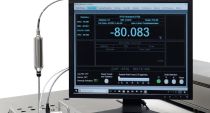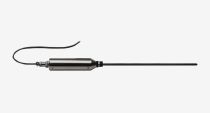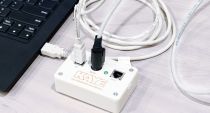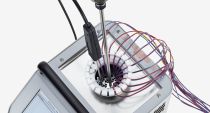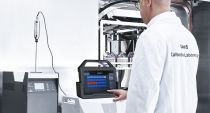Part 3 of this blog post series deals with another important part of the measurement philosophy that Kaye established early on as a system supplier for measurement systems for the validation of thermal processes. As early as 1972, with the introduction of the first Kaye Validator Digistrip I, it was clear that a data recorder or data logger (Blog Post Part 1) for data acquisition and the calibration furnaces and baths described (Blog Post Part 2) were only part of the journey towards an automated validation system.
For a sensor to be used in calibration, regardless of whether it's a thermocouple or a Pt-100, it is imperative that it is calibrated and adjusted before the actual data recording begins. In the 1960s and 70s, the calibration and adjustment of temperature sensors were relatively time-consuming, manual, and thus, prone to errors. It became clear: A complete calibration system needs a traceable temperature standard to enable a standard-compliant calibration.
In the context of reducing user-dependent errors, a maximization of the degree of automation of the hitherto largely manual calibration process was aspired. Furthermore, an additional development focus of the Kaye innovation team was on a significant improvement of the temporal progression of the calibration, including several calibration and adjustment points.
Thus, the next stages of development in the evolution of Kaye's validation systems were already established in the late 1970s:
1. The necessity for a highly accurate, robust, and traceable temperature standard was recognized, one that could also withstand the high demands of mobile applications.
2. There was a push to provide a largely automated and user-independent calibration process to eliminate potential user-related sources of error.
At this point, a brief excursion into the topic of traceability may be helpful. Even though this topic has the potential for its own blog post, we still want to briefly illuminate this term in the context of the Kaye IRTD.
Short explanation of traceability
The traceability of temperature standards is essential in metrology to ensure the accuracy of temperature measurements. Through a continuous chain of comparison, it is ensured that the measured temperature data is traceable back to an internationally recognized standard, such as the National Institute of Standards and Technology (NIST) or the Physikalisch-Technische Bundesanstalt (PTB). Therefore, temperature normals must undergo calibration processes that verify their measurement accuracy against these standards and document this in corresponding calibration certificates. This chain of traceability is described in detail in the respective technical literature and is vital for adhering to quality standards in industry and science.
Returning to Our Primary Focus: The Implementation of Automation in the Calibration
At that point in time, the traceable temperature standards that were available typically provided an analog output signal of 0-10V or 4-20mA. This necessitated a separate, often expensive, electronic evaluation system. To overcome this limitation, the Kaye development team, in collaboration with external specialists, developed the Kaye IRTD 400. The result is a highly accurate, traceable temperature standard based on a resistance thermometer that directly converts the measured temperatures (or respective resistances) into a digital output signal. This innovation is already reflected in the product name, with the "I" standing for "Intelligent" (some might also say "Innovation"), and "RTD" standing for "Resistance Thermometer".
This groundbreaking development from over 40 years ago is demonstrated by the fact that since the market introduction of the Kaye IRTD 400, only minimal changes have been made to the components used and the original design. This shows that thoroughly conceived and well-thought-out designs often only need fine adjustments to stay relevant and effective over time.
The generation of a digital output signal enabled seamless integration with both Kaye's data acquisition systems and data logger systems. Additionally, it was compatible with the digital output signals of Kaye's calibration furnaces and baths. With this development, the second challenge was successfully overcome: a fully automated calibration and adjustment process could be realized.
What are the fundamental, innovative features of the Kaye IRTD 400?
The Kaye IRTD 400 is an innovative, traceable temperature standard. Its high precision and wide temperature range of -196 to 420 °C make it the ideal measuring tool for calibrating sensors in pharmaceutical and biotechnological applications. One of the groundbreaking features of the IRTD 400 is its ability to enable largely automated sensor calibration in conjunction with Kaye data loggers or data recorders, and their extensive range of Kaye calibration baths and ovens. The available add-ons, the IRTD WinSoftware and the external IRTD display, allow for intuitive operation and efficient real-time communication with up to two IRTDs. The Kaye IRTD display, a sophisticated touchscreen device, provides a clear representation and accurate analysis of the temperature data from various IRTDs. Both units support standard connecting cables, further enhancing the accuracy and efficiency of calibration in industrial and scientific contexts.
The realization of the first complete, largely automated validation system marks a significant milestone in the history of industrial measurement technology. This system, consisting of Kaye data loggers or recorders, the universal series of Kaye calibration baths and ovens, and the Kaye traceable temperature standard, represents an impressive advancement in the validation of thermal processes in line with GxP regulations. Since its market introduction, this system has received widespread recognition and has brought about a significant paradigm shift in the workflows of its users.
In addition, the global network of Kaye calibration laboratories accredited in accordance with ISO 17025 ensures the assurance of traceability to national standards without any gaps.
To enquire about a product or service, you can reach out to us online and one of our representatives will be happy to assist you! To contact us, please visit us here: https://www.kayeinstruments.com/en/contact
To request a demo of any of our products, please visit our demo request website here: https://www.kayeinstruments.com/en/demo
Follow us on LinkedIn or register for our newsletter: https://www.kayeinstruments.com/en/newsletter-subscription
Copyright: Amphenol Corporation



